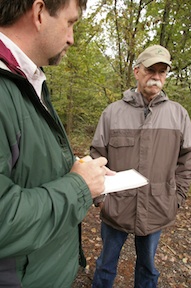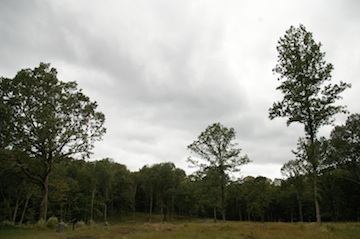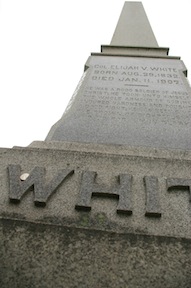Ball’s Bluff: A Conversation with Author James Morgan About His New Book, A Little Short of Boats
First in a series

James Morgan didn’t set out to write a book. “It was accidental,” he says, “like the battle. I just ended up writing a book.”
We’re walking across a small clearing, some three hundred yards or so of open ground that dips into a ravine and then rises back up before dropping more than a hundred steep feet to the Potomac River. There’s a cemetery on the far rise just before the big drop.
This is Ball’s Bluff, and Morgan is the man who literally wrote the book on the battle: A Little Short of Boats: The Civil War Battles of Ball’s Bluff and Edwards Ferry, October 21 – 22, 1861, published by Savas Beatie.
“Sometimes you stumble across something and you find your niche, and this is mine,” Morgan says.
Morgan, 63, a librarian for the U.S. Department of State by profession and battlefield guide by avocation, first discovered Ball’s Bluff in 2000. At the time, the town of Leesburg and the Northern Virginia Regional Parks Authority (NVRPA) acquired 141 acres of land adjacent to the small plot already set aside for the battlefield and the Ball’s Bluff National Cemetery. The battle itself, though, which took place October 21, 1861, had largely been forgotten.
NVRPA wanted to change that. After they acquired the land, the authority decided to start up a guide service to offer regular interpretation of the site. Morgan was among those who responded to the call for volunteers.
“But at the time, I didn’t know anything about Ball’s Bluff,” he admits. “I’d done tours at other Civil War sites. I thought I could do some homework, you know, read some books, and I did and started giving tours out here.”

He stops along the gravel causeway that crosses the clearing and looks at the ground, nodding. “I literally just stumbled into it, and one thing lead to another,” he says, “and I really have come to love this little place.
Morgan calls the Battle of Ball’s Bluff “a neat little story.”
“It’s not unique—there are lots of little battles—but it has a place because it’s early in the war…. Because there were really several months before the really big battles started happening, this had a bigger role at the time. And then of course, once the real battles start, then this kind of drops off the face of the earth and it gets lost in the mix.”
Morgan fishes for a quote from Union commander Charles Stone, writing to historian Benson Lossing. “He said, ‘Ball’s Bluff was like an unnoticed morning skirmish on the Petersburg’s lines.’ And it’s true. It’s true. At Petersburg, those guys were slamming into each other every single day, several times a day, in groups of this size, fighting for a few hours,” Morgan says.
“But in 1861, this mattered. This really mattered. They did not have a clue what was going to fall down on their heads in the spring of 1862 when the real war starts and the real big battles start.”
As Morgan got more involved with the guide service and better versed with the story, he felt something start nagging at him.
“That first summer it just kind of struck me, because I spent a lot of time walking the land, looking at maps and comparing the lay of the land with texts that said certain things happened at certain places, and I decided that a lot of stuff about the way the story was told was wrong,” he says. “So, I started digging around, looking for answers, going to the National Archives, looking at regimental records, and things like that, and became convinced, in fact, that the story was wrong.”
Basically, he says, the story of the Battle of Ball’s Bluff had been told as a bungled attempt to implement an existing plan to take Leesburg.

“It started out, really, with Elijah White, about 1902 or so,” Morgan explains. White, a local boy who would later rise to the rank of lieutenant colonel and earn fame as commander of “White’s Comanches,” served with the 7th Virginia Cavalry but happened to be home on leave. “He hears the shooting and he says, ‘Here, I’ll volunteer. I’ll help.’
“Well, years later, forty years after the war, he writes what is really the first lengthy account of the battle. There had been some newspaper articles, solider memoirs, but he wrote was really…kind of a booklet. And what he did, forty years after the fact, was get a lot of stuff wrong because he was reading the then-very-new ORs, and a lot of the stuff in the ORs is wrong. And of course White had been through the war, and he still believed that idea that this had been a pre-planned attempt by the Yanks to take Leesburg, partly because people were expecting something like that to happen. They had lost Bull Run. McClellan comes in and ‘On to Richmond.’ Everyone on the Southern side, they can read the Northern newspapers and see how much pressure is being put on McClellan to do something. He’s been in command a couple weeks, so do something, do something.
“Everybody knew that at some point the Yanks were coming, so they were expecting an attack—but nobody knew when.”
So, Morgan says, “When this thing finally did develop, it looked like what the Confederates had been expecting—but in fact, it was just this little raiding party. They had just come out to raid this little camp they thought was out there that wasn’t really out there. They were just going to raid the camp and go back. And then General Stone had sent a few men over the river at Edwards Ferry as a sort of a diversion in favor of this raiding party.”
Add to that a large body of Federal troops in Dranesville, and Morgan says it was a situation ripe for misinterpretation. “If you’re the Confederate commander here in the middle of all that, and you’ve been expecting them to attack you—here they come!” he says. “He misinterpreted what was happening. He didn’t know that this was just a little raid; he didn’t know that the cavalry at Edwards Ferry was just 30 guys who were going to make some noise. He thought they were going to keep coming. So it had the appearances that reinforced the expectations.”
That’s how the story got passed down over the years, Morgan says. “So when Elijah White wrote his thing in 1902, that’s the story he told, and everybody that came after him pretty much just accepted it,” he explains. “They kept repeating it and kept repeating the error, so it gains credibility from repetition.”
White wasn’t the only one who added to the confusion, either. “You get all sorts of weird little stories that are told by the veterans forty years later who are confusing something that happened in 1863 with Ball’s Bluff,” Morgan says, “and ‘I remember such-and-such,’ and you check it out, and such-and-such didn’t happen here, it happened at Chickamauga or something. That’s part of what you get with research.”
Morgan told the traditional story during his first year, but admits he was “becoming more and more uncomfortable telling it—and that’s not good.”
“I’m a guide, and I’m sort of presenting myself to the public as the knowledgeable person here, and I’m not telling these people the truth, and I got very uncomfortable with that,” he says. “So I really just started digging around to answer my own questions.”
Once he started digging and really became convinced that the story was being told incorrectly, he says he went back and took a second look at a lot of the research to clarify for himself the problems with the story as he saw it. He didn’t set out to write a book, although is work eventually evolved into a book project at the urging of several friends and fellow guides.
“I started writing, making notes,” he says. “I had no publisher. I didn’t have a deadline. And I was just writing down the story.”
About halfway through work on the manuscript, Morgan got an out-of-the-blue phone call from historian/author Eric Wittenberg, who ran a small press called Ironclad Books. As Morgan recounts the conversation: “Eric said, ‘Ironclad is thinking about doing a series of half-a-dozen books or so on lesser-known battles, and I know you know a lot about Ball’s Bluff. Would you be interested in writing a book about Ball’s Bluff for me?’ I said, ‘Well, as it happens….’ So it just fell in my lap. Sure! Absolutely! Everything fell into place like that.”
The first edition of the book came out in 2004, but almost immediately, Morgan began to collect new information on the battle, and he eventually realized he needed to update the book. Because Ironclad doesn’t publish hardcovers—and Morgan wanted the updated edition to be hardcover—Wittenberg released the rights so Morgan could approach Savas Beatie, which released the updated volume in July.
“There is a lot of information in the second book that’s not in the first one—because I didn’t know it at the time,” Morgan says.” There were a few little mistakes in the first one that we corrected.”
Morgan says he’s been gratified by the response to the book thus far (Emerging Civil War will offer its own positive review later this week). But he’s been even more gratified by the attention the battlefield has been getting.
“It has, for so long, been obscure because it is so small,” he says. Having the opportunity of the sesquicentennial following so close after all the effort we’ve made over the past few years, the guide service, my book, the new signs, the new trails that have been cut in—we want to bring Ball’s Bluff to people’s attention in a way it hasn’t been before.
“And I’m pleased to have been a part of that, to get this story told properly.”
—————
Join us in a few days for more of our conversation with Jim Morgan as he shares some of his insights on the Battle of Ball’s Bluff. He’ll also give us a behind-the-scenes look at how the battlefield was preserved and developed, and he’ll take us inside Ball’s Bluff National Cemetery.
I will be proudly reenacting at Ball’s Bluff on the 150th anniversary of the battle with the 15th MVI. It’s actually the day after the anniversary since the reenactment is on October 20th. Anyone who is close by should come a visit the battlefield and the reenactors. We will actually have POWs after the battle which is scheduled to be from 2 to 3.
Good luck with the reenactment, Paul!
One correction to what Mr. LaCroix wrote: the date of the reenactment is Saturday, October 22. The anniversary is the 21st but these things are best done on weekends so the reenactment will actually be 150 years and one day after the battle. Ball’s Bluff has never before been reenacted on the actual battlefield and very likely will never be again.
Check out http://www.150thballsbluff.com for more information.
Having seen some of the work first-hand, I was really impressed with the preparations that have gone into getting the battlefield ready for the event.
Thank you for mentioning our book, A Little Short of Boats. As always, we appreciate the support! You can visit the book page at: http://tinyurl.com/2f5cfcu
Savas Beatie LLC
Publisher of Historical Titles of Distinction
http://www.savasbeatie.com
http://www.facebook.com/#!/pages/Savas-Beatie-LLC/92556804326
Always a pleasure!
If you haven’t visited Ball’s Bluff Battlefield, do so. This field has “feel” like few others–especially if you are alone or with a small group. Bring Jim’s book and guide. If you come about the time of the re-enactment, you will see what the soldiers saw as they died–gorgeous foliage. But standing in the small National Cemetery, with all but one grave (that of James Allen of Northbridge, Mass.) marked “UNKNOWN,” you will have a very different feeling. Thanks go to Jim Morgan for his book, this interview, and his recent article in the Civil War Trust’s magazine HALLOWED GROUND.
We have more on Ball’s Bluff and Jim’s book coming up, Richard, so be on the lookout.
Jim does a great tour! if you have read his book, its a great way to see where it happened. Also, check out our video on Ball’s Bluff with Jim here. http://youtu.be/HR9vsK6VIo0
As a new guide at Ball’s Bluff, I’ve been inspired by Jim and greatly enriched by his knowledge and willingness to share it while on walks around the site.